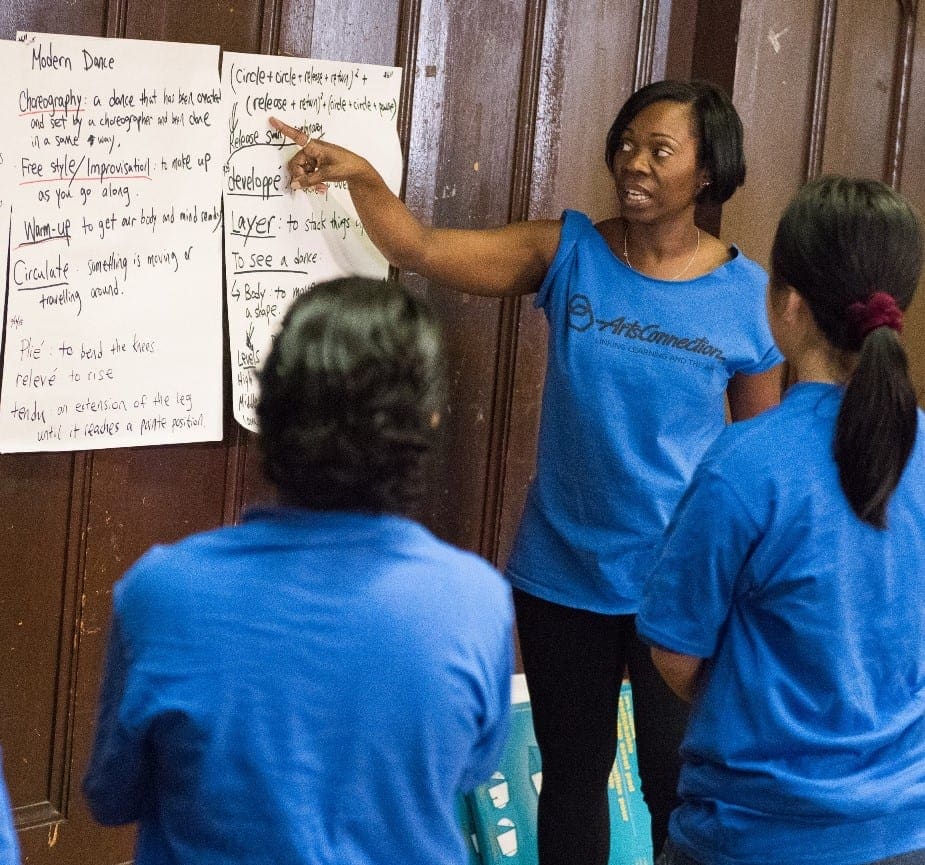전환 101
 노력하다
노력하다
지침을 제공하기 전에 학생의 주의를 집중시키는지 확인하세요.
 노력하다
노력하다
전환을 활용하여 이해도를 다시 확인하고 수업의 요소를 통합할 수 있습니다. 예를 들어, "그리기로 선택한 동물이 되어 책상으로 돌아가세요." 또는 "레가토로 책상으로 돌아가세요."와 같이 말이죠.
 노력하다
노력하다
놓으세요. 미리 알림을 주고 싶은 충동이 강할 수 있지만, 미리 알림을 추가하면 학생의 집중력이 흐트러지고 전환에 방해가 될 수 있습니다.
안건 게시
모든 사람은 앞으로 무엇을 기대해야 하고 어떤 일이 일어날지 알고 싶어 합니다. 스마트 보드, 차트 용지 또는 시각적 일정표와 같은 보다 가시적인 대안이든, 안건은 교수자, 학생, 교실 전문가 모두가 계획대로 진행되도록 도와줄 수 있습니다. 시각 자료를 사용하여 안건을 지원하는 것은 다양한 학생에게 유용할 수 있습니다.

사진 제공: 아트커넥션 티칭 아티스트 김그리어
팁
교사가 학생들이 글을 정리하는 데 어떤 도구와 기법을 사용하는지 확인합니다. 그런 다음 안건을 작성할 때 이러한 구조를 강화할 수 있습니다(예: '먼저', '그다음', '다음', '마지막').

사진 제공: 아트커넥션 브릿지 프로그램 티칭 아티스트 리마 판드(Rima Fand)
음악 사용
음악을 사용하여 전환의 길이를 안내하고 제어할 수 있습니다. 스타일과 비트는 학생들이 전환하는 방식에 대한 분위기를 설정하는 데 도움이 될 수 있습니다. 드럼, 레인 스틱, 젠 차임, 부처 그릇, 종 또는 꽹과리 같은 악기를 사용할 수 있습니다.
익숙한 노래나 노래의 한 부분을 재생하면 학생은 전환해야 하는 시간을 정확히 알 수 있습니다. 전환하는 동안 함께 노래를 부르거나 외칠 수도 있습니다.
시각적 타이머 또는 시각적 카운트다운 시스템 사용
타이머는 학생에게 남은 시간을 정확히 알려주고, 전환을 예상하여 아무도 놀라지 않도록 합니다.
프로메테안 보드를 사용하는 경우 대시보드 또는 메인 메뉴에서 타이머 아이콘을 클릭하면 시계, 스톱워치, 타이머 등 다양한 기능을 갖춘 타이머 앱이 내장되어 있어 쉽게 찾아서 사용할 수 있습니다. 타이머를 위한 프로메테안 보드 지원
온라인 타이머에 대한 아이디어를 살펴보세요: 온라인 스톱워치 교실 타이머.
이동 추가
전환을 예술성과 연결할 방법을 찾아보세요. 예를 들어, 학생에게 레가토 또는 스타카토로 움직이게 하거나, 비틀어진 동작으로 전환하거나, 연극에서 캐릭터를 선택하여 책상으로 돌아가도록 할 수 있습니다. 학생에게 연기를 할 수 있는 지침(예: "스파이처럼, 발끝으로, 슬로우 모션으로, 닌자처럼, 카펫으로 이동" 등)을 제공합니다.
성공적인 전환을 위해 원하는 특성을 구현하는 운동 유형을 선택하는 데 유의하세요.
원격 교육 및 학습 팁
디지털 공간에서도 전환을 위한 시간을 확보하고 전환을 명확히 해야 합니다. 비동기식 수업의 경우, 반성 질문에 응답하고 전환할 시간을 확보하기 위해 잠시 멈추는 시간을 포함하세요. 실시간 수업의 경우 전환에 대해 명확하게 설명하고 충분한 시간을 확보합니다. 화면에 타이머를 사용하여 학생이 남은 시간을 알 수 있도록 합니다. 학생을 시간 관리자로 지정하여 학생의 리더십과 모델링을 장려합니다.


